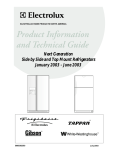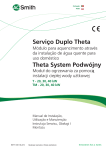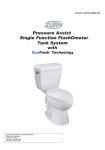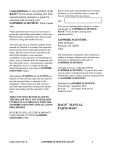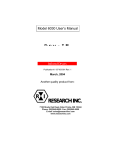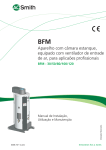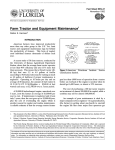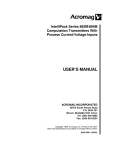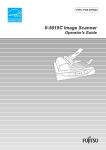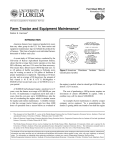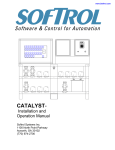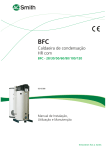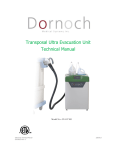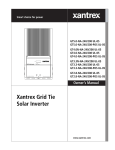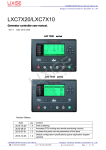Download GREENER HOMES PILOT PROGRAM ENERGY REDUCTION
Transcript
GREENER HOMES PILOT PROGRAM ENERGY REDUCTION PLAN Eastern Ave Apartments 30 Eastern Ave Concord New Hampshire 03301 Owner: CATCH Neighborhood Housing Phone: 603-225-8835 Property Manager: Gerald Walsh Audit Date: May 26th, 2010 Report Contracted by: New Hampshire Housing Finance Authority Report Prepared by: TRC Energy Services Report Date: June 24th, 2010 TRC Energy Services 155 Fleet Street, Suite 305, Portsmouth NH 03801 TABLE OF CONTENTS EXECUTIVE SUMMARY ........................................................................................................................................... 2 SECTION I. EXISTING CONDITIONS ...................................................................................................................... 5 Building Ownership, Management, and Staffing ...................................................................................................... 5 Management and Education Options ......................................................................................................................... 5 Building Occupancy .................................................................................................................................................. 6 Energy Suppliers, Metering, and Electrical Systems ................................................................................................. 6 Envelope ..................................................................................................................................................................... 6 Infiltration..................................................................................................................................................................... 7 Mechanical Systems .................................................................................................................................................. 8 Domestic Hot Water ................................................................................................................................................ 10 Ventilation ................................................................................................................................................................ 10 Lighting ................................................................................................................................................................... 11 Laundry Equipment & Appliances ........................................................................................................................... 11 Elevators .................................................................................................................................................................. 12 Health & Safety ....................................................................................................................................................... 12 Indoor Air Quality ................................................................................................................................................. 12 Operation and Maintenance ..................................................................................................................................... 12 Management & Education ....................................................................................................................................... 13 SECTION II. EVALUATED MEASURES ................................................................................................................ 14 TABLE OF FIGURES Table 1: Benchmarking Results and Performance Target Table 2: Energy Reduction Plan Summary Metrics Table 3: Detailed List of Recommended Measures for Entire Project Table 4: Benchmarking Tool & Design Assistant APPENDICIES Appendix (A): Analysis of Fuel Bills/Water Savings Calculations Appendix (B): Modeling Reports Appendix (C): Refrigerator Inventory & Bath Fan Info Appendix (D): Table of Evaluated Measures EXECUTIVE SUMMARY A comprehensive energy assessment that evaluated a suite of potential measures to achieve the facility’s energy performance target and improve the health, safety, comfort, and security of its residents and staff was conducted at Eastern Avenue Apartments. The findings and recommendations of this assessment are detailed in Sections I and II. Based on this initial assessment, a scope of work has been proposed in consultation with the building ownership and management that will effectively achieve energy savings in Section II. The energy reduction summary metrics and the detailed list of recommended measures are presented in Tables 1 and 2. This report contains an Energy Reduction Plan (ERP) which details specific steps to be taken by the ownership and management at Eastern Avenue Apartments to achieve estimated energy savings. This facility was benchmarked against other Housing and Urban Development (HUD) buildings to evaluate and compare its current energy consumption relative to similar buildings in the U.S. in the Benchmarking database. The benchmarking results are presented in Table 3. Eastern Avenue Apartments achieved a benchmarking score of 68. This places Eastern Avenue Apartments in the 3rd quartile as compared with multi-family buildings nationwide. Eastern Avenue’s reduction target is 28% of the building's current source energy. Table 1: Energy Reduction Plan Summary Metrics Total Investment: Annual Savings: Summer Peak Demand Reduction: New Gas: Electric Reduction: $49,537 Payback Period (years): $4,616 Savings to Investment Ratio: 288 million Btu Net Life Cycle Savings: 7,029 kWh Discounted at 3.0% over (yrs): 6.2 kW Project Phased over: 0 million Btu (New purchases for cogen, conversions) 11% Fuel Use Reduction: 10.7 1.26 $13,092 17.7 1 years 37% 2 REPORT Table 2: Detailed List of Recommended Measures for Entire Project Measure Installed Cost (incl. design) MMBtu Energy Savings Measures Infiltration Reduction & 1 Window Replacement Single pane Install Modulating Boiler 2 and controls Replace Table lamp 3 bulbs Replace old Ceiling 4 FIxtures 5 LED Exit Signs Refrigerator 6 Replacement 7 Energy Star Washers Water Heater 8 Replacement Low Flow Device 9 Installation Heath & Safety Measures 10 0 Total for Improvements TOTALS Annual Annual Annual Demand Water/ O&M Cost Payback Savings Sewer Savings Savings Savings $ $ years kW 1000 gals Annual Energy Savings kWh S.I.R. Life Years Cycle for LCC Savings $ years $17,400 119 370 0.0 0.0 $0 $1,448 12.02 1.24 $4,138 20 $26,000 50 0 0.0 0.0 $0 $577 45.03 0.33 -$17,411 20 $96 -3 1,106 0.1 0.0 $0 $172 0.56 8.19 $690 5 $480 -1 412 0.0 0.0 $0 $63 7.59 1.96 $461 20 $360 -1 511 0.1 0.0 $0 $79 4.54 3.28 $821 20 $3,000 -10 4,635 6.0 0.0 $0 $725 4.14 3.46 $7,380 19 $1 6 0 0.0 6.0 $0 $68 0.01 767.34 $766 14 $1,800 92 -5 0.0 0.0 $0 $1,064 1.69 8.80 $14,032 20 $400 36 0 0.0 96.0 $0 $420 0.95 6.54 $2,216 7 $49,537 288 7,029 6.2 102 $0 $4,616 $49,537 288 7,029 6.2 102 $0 $4,616 $0 $13,092 10.73 1.26 $13,092 Notes: The SIR calculation uses a discount rate of 3% per annum. The individual measures in the package are meant to work together to deliver sustained, comprehensive energy savings, therefore certain measures may have a negative life cycle savings. Modeled price of Oil was $2.66 per gallon. Modeled price of Electricity was $0.139 per kWh, no energy cost escalation is factored into this formula. The cost of replacement of the Energy Star washers is negligible because this equipment is owned by the Laundry Equipment Corporation of Manhester, NH. 3 REPORT Table 3: Eastern Avenue Apartments Benchmarking Results Building(s) Description Weather Description Project Name: Eastern Typical "optional entry" 5-digit Zip Code: 03301 Mapping Location: Concord, NH Entire Building Gross Floor Area (sqft) Number of Family Units 17,101 14 Not Sure? Percent of Units Percent of Gross with Laundry Floor Area Hookups Heated MMBtu Natl Gas/Propane Natl gas MMBtu Energy 212 628 Cost ($) 9,623 5,977 1 1 No. of buildings 7554 Annual CDD: 328 328 IMPORTANT: Annual entries should correspond to the same time period as the pre-/post-retrofit annual consumptions reported below. Pre- or post-retrofit values must be provided to score your building. Percent of Gross Floor Area Cooled IMPORTANT: Entries should represent 12 continuous months of consumption Pre-Retrofit Units: 7554 100.0 Annual Energy Consumptions and Costs ----Electricity Pre-Retrofit Post-Retrofit Annual HDD: Post-Retrofit Fuel Oil MMBtu District Steam Electricity MMBtu Natl Gas/Propane Natl gas therms kWh Fuel Oil MMBtu Gal #6 District Steam MMBtu IMPORTANT: Number of buildings represented by the reported energy use values above should always be equal for all reported fuels. Calculated unit cost: 45.39 $/unit 9.52 $/unit $/unit Results $/unit $/unit Pre-Retrofit $/unit Average 68 50 50 840 NA NA Building Source Energy Use (MMBtu/year) 1,366 1,621 1,366 Site Energy Use Intensity (kBtu/ft2-year) 49.1 NA NA Source Energy Use Intensity (kBtu/ft2-year) 79.9 94.8 79.9 Building Site Energy Use (MMBtu/year) $/unit Post-Retrofit Your Building Score Against Peers $/unit Your Building Average Weather-normalized Percent Source Energy Use Reduction After Retrofit Projected Annual Energy Consumption Design Assistant Electricity Units: Energy MMBtu 188 Natl Gas/Propane Fuel Oil MMBtu Natl gas MMBtu District Steam MMBtu 340 Projected Percent Source Energy Reduction Projected Score Against Peers Projected Building Site Energy Use (MMBtu/year) 28% 85 528 Projected Building Source Energy Use (MMBtu/year) 985 Projected Site Energy Use Intensity (kBtu/ft2-year) 30.9 Projected Source Energy Use Intensity (kBtu/ft2-year) 57.6 4 REPORT SECTION I. EXISTING CONDITIONS Eastern Avenue Apartments, located in Concord, New Hampshire, consists of 14 apartment units in one large building. The building is a two story above grade building with the rear basement fully exposed. Each unit does not have an exterior door with the exception of a few providing exterior access. Each apartment unit comprises a kitchen/dining area joined to the living room, bathroom and a single bedroom. This complex, built in 1945, sits just off Rte 132, with the front of the building facing southwest. Eastern Avenue Apartments are located in a multi-family residential area not far from downtown, with a few other multi- story buildings surrounding it. There is nearly no shading provided except by the neighboring trees on the grounds. There are tall buildings nearby that provide additional wind shielding. On May 26th, 2010, Multifamily Building Specialist Dan Ramage and Michael McQueeney of TRC visited the project site and preformed a detailed energy assessment of the property. On the day of the assessment, the temperature outside was in the high-80's with a clear sky. As part of the energy assessment, all of the apartment units were assessed and accounted for. BUILDING OWNERSHIP, MANAGEMENT, AND STAFFING The building is owned by CATCH Neighborhood Housing, of Concord, NH. The facility maintenance is performed by Gerald Walsh of MB Management and his staff. Major repairs and capital improvement projects are sub-contracted. MANAGEMENT AND EDUCATION OPTIONS The building staff appears to have a working knowledge of energy efficiency issues but no formal training was conducted. Though no written preventive maintenance schedules were evident, routine maintenance tasks are performed. Total utility expenses are recorded annually and consumption is gauged by cost. Currently, no incentive program is in place to encourage energy 5 REPORT efficient behavior by the staff and residents. Some residents appear to have only a rudimentary understanding of energy efficiency and its benefits. BUILDING OCCUPANCY At the time of the site assessment, the facility was occupied mostly by seniors. With one resident per unit on average, Eastern Avenue Apartments totals about 20 tenants. All of the tenants are over the age of 55 and must qualify as low income for the local area to live at the complex. ENERGY SUPPLIERS, METERING, AND ELECTRICAL SYSTEMS The facility has a common area electric meter and an individual electric meter for each apartment unit. Electricity is supplied by Unitil and the electrical systems appear to be in good condition. Natural gas is master-metered. Natural gas is supplied by National Grid, which is used for space heating and domestic hot water (DHW) production. During the twelve-month analysis period (April 2009 - March 2010), the facility’s energy consumption was as follows: Utility Natural Gas Electricity Consumption 6,281 62,081 Units Therms kWh Cost $7,267.40 $9,622.00 Blended Rate $1.16/therm $0.155/kWh Please note that the electricity consumption for all the apartment units was estimated using 250kWh/month as the average consumption. This average is weather normalized. TRC anticipates working with the Management Company and tenants to verify this assumption. Domestic water and sewer services are provided by the City of Concord. Water saving measures will reflect savings on the water bills, as well as quantifiable savings will result from reduced hot water demand. Please refer to Appendix A for detailed utility data usage and costs. ENVELOPE The building walls have approximately three and a half inches of blown in cellulose insulation from an upgrade possibly installed by the local community action energy program. The ground floor is built on slab at grade level with 1” foam board, 2x4 wood framing, sheathing and a white clapboard exterior cladding. There is an existing walk-out basement at the rear of the building. 6 REPORT The average occupied apartment temperatures measured 72.5 degrees. There are approximately 77 window openings present in the complex, majority being white vinyl replacement windows in good shape. They are double pane with no low/e coating. The lower level windows in the rear of the building are single pane with 6 over 6 individually glazed panes of glass and a few single pane glass small awning type windows. All single pane windows appeared to have loose fitting metal storms. The vinyl windows are in good condition with no evident seal failures. The mechanicals are intact and operate well. There are a total of 12 steel insulated exterior doors to the complex and generally in good condition. Weather-stripping is present and intact on all doors. All buildings have pitch roofs with medium to dark asphalt shingles. The roofing appeared to be in excellent condition. A CDX wooden roof deck supports the roofing and is securely fastened to the roof trusses. Soffit and ridge vents supply roof ventilation along with two non-functioning thermostatically controlled gable end fans. Interior attic access is via two full size steel insulated doors on the top floor. The attic space, revealed approximately 3” inches of rockwool fiber under about 11 inches of blown cellulose insulation. After examining the attic flat it was apparent that many gaps around plumbing and electrical penetrations were not sealed prior to insulating. Wall to ceiling connections and open knee-wall spaces also need to be sealed. INFILTRATION Infiltration to the apartments occurred through: minor cracks around windows units with missing drywall ceilings (above 2 x 4 drop down ceiling tiles) framing connections; base of walls and tops of interior walls electrical outlets installed on walls with interstitial space between them (infiltration occurs through the top plates of the wall) plumbing penetrations which are connected to the attic space 7 REPORT around the kitchen exhaust fan ductwork knee-wall wall spaces on the attic side allowing air into the walls When infiltration occurs, unfiltered air moves from unhygienic/unwanted areas into conditioned living spaces. This can negatively influence indoor air quality and health and safety. Measured Complex Blower Door Metrics Average Apartment Square Footage 476 Measured Blower Door Ranges (cfm/50) 998 to1026 Average ACH – natural .79 to.87 ASHRAE Standard (ACH) .35 Tight as possible, while maintaining controlled mechanical ventilation Best Practices Recommendations Infiltration (in air changes per hour) at this facility is quite high and at least twice the ASHRAE standards. A great portion of the air leakage occurs due to the missing drywall ceilings that have been covered over with tiled drop down ceiling. Since air leakage in buildings can represent anywhere from 5% to 40% of the space-conditioning costs, it's important to control the infiltration while maintaining good ventilation. This will improve tenant comfort, reduce large temperature swings and will prevent ice dams. MECHANICAL SYSTEMS Space Heating All mechanical equipment is in its own self contained area in the basement. Well McClain model # CGB-6 650,000 BTU water filled atmospheric boiler is used for space heating and runs a continuous loop to feed the apartments units. This boiler is greatly oversized at the building’s current heating requirement. It lacks proper indoor /outdoor controls to operate the boiler. This boiler should be upgraded to an ENERGY STAR boiler, sized for the building‘s heating load and along with the appropriate boiler control system. This boiler does not provide 8 REPORT domestic hot water. The apartments use hydronic baseboard with thermostatic valves controlled by wall-mounted, 3 wire, 24 volt mercury based dial thermostats. The average temperature in the apartments units and common spaces was 72.5 degrees on a day with outside temperature of 88 degrees. Combustion air is supplied through a large open louvered exterior vent through ductwork. The following boiler combustion efficiency data was obtained on site: Boiler DHW Make Model Year Size Well McClain CGB-6 1970 650K BTU AoSmith N/A 1970 180K BTU Fuel Building Natural Gas 1 83% 11 N/A 670° Natural Gas 1 70% N/A N/A N/A Efficiency CO (ppm) Draft (pa) Stack Temp (F) DHW AoSmith N/A 1970 180K BTU Natural Gas 1 70% N/A N/A N/A Insulation was found on most but not all of the distribution pipes in the mechanical room. 9 REPORT DOMESTIC HOT WATER In the same mechanical room, two old 80- gallon natural gas independently fired atmospheric hot water storage tank provide DHW and these vent into the chimney. These tanks run a continuous loop with circulator pumps. Each tank rated at 180,000 Btus is oversized for the building’s current DHW needs and are very inefficient compared to an indirect fired domestic hot water setup. The water temperature in the apartment units ranges between 125 to 130 degrees. All showerheads were 2.5 gallons per minute (GPM), all kitchen faucets were 2.2 GPM and bathroom faucet aerators were 2.0 GPM. Approximately half of the apartment toilets have been upgraded from 3.5gpf to 1.6gpf. VENTILATION The ventilation system for the complex consists of both kitchen range hoods and bathroom exhaust fan light combinations. Each apartment is equipped with both of these fans. Bathroom exhaust fans were rated at an average of 80 cfm. The kitchen exhaust fans are rated at 170cfm and are functional. However, upon inspecting each apartment unit; a few observations were made. Majority of bathroom exhaust fans have been replaced by low sone (noise) 80-110 cfm fans with a time delay switch. The time delay switch can also be a light switch. Upon turning the switch on, the lights and fan should both come on and when switched off the fan will continue to run for the allotted time period it was initially set up for, usually 10 minutes. This allows removal of excess moisture and odor. It is important to do a routine exhaust fan grill cleaning to ensure efficient operation. Unit #5 had an older fan/light fixture with a missing lens cover while units #11 and #12 could use a exhaust fan grill cleaning. Kitchen hoods operate on switches and according to some tenants, are used sparingly. All kitchen and bathroom exhaust fans appear to be vented to the outside; however, during any attic insulation upgrade this should be verified. 10 REPORT LIGHTING Each apartment has, on average, two ceiling fixtures and a bath/fan light combination. All apartment lighting operates on wall switches. The apartment light fixtures were mainly fluorescent with twin biax bulbs, though some older incandescent fixtures are present in certain units as noted below. All units had around one to four table or floor lamps using incandescent light bulbs that should be upgraded to fluorescent. Lighting in the residential common areas consists of flush mounted 4 foot T-8 fixtures, each containing two 32W T-8 with an advantium ballast using 62 watts each. All laundry area lighting operates on wall switches. Exit signs contain 32W incandescent bulbs but of the four exit signs only one was operational (probably due to burnt out bulbs). We recommend an upgrade to LED exit signs for longevity and savings. Area or Unit # Wattage Needs Replace # of Fixtures Unit #1 120 Yes 1 Unit #7 120 Yes 1 Unit #9 120 Yes 1 Unit #11 120 Yes 1 LAUNDRY EQUIPMENT & APPLIANCES The facility provides each tenant with a refrigerator and electric range. Other small appliances are found on most kitchen countertops. There are no dishwashers present. Most apartments have 14 or 15 cubic foot refrigerators that are approximately 1-5 years old. Manufacturers varied including Sears, Hotpoint, GE and Frigidaire. Six old refrigerators (1999) must be replaced. Please see spreadsheet in Appendix C. Two sets of laundry equipment, used by the tenants, are located in the basement and owned by a private company. The equipment is coinoperated and not Energy Star rated, so its water usage is high and inefficient. No sign of corrosion or wear is present. The clothes dryers are properly vented outside. Although no coin-collection data was available, 11 REPORT based on maintenance staff interviews, a total of 20 loads per week were estimated for this equipment. ELEVATORS There are no elevators in the building. HEALTH & SAFETY There is a smoke detector present in each apartment unit. As none of the apartments contain fossil fuel-burning appliances, there is no need for carbon monoxide detectors. However, we recommend carbon monoxide detectors in the common areas. No obvious safety hazards or concerns were observed at this facility. INDOOR AIR QUALITY Currently the existing fans seem to be working sufficiently with a few minor exceptions as noted on the bath fan/refrigerator sheet. It looks as though the building may have participated in a weatherization program in the past that addressed bath fans and proper venting along with time delay controls which are all intact. OPERATION AND MAINTENANCE We recommend developing a written O&M plan, so that a successor can gain historical insight into the building, its improvements and operation. Adopting O&M strategies helps efficient operation of expensive building equipment and systems and reduces risk of early equipment failure, unscheduled down time, utility costs and tenant losses. This facility may already be following certain O&M practices. However, without written documentation, efficiently accounting for the returns is difficult. The following O&M practices can be performed on a regular basis: Cleaning A/C coils Clean and tune boilers Check window & door weather-strips and replace as required Clean bathroom exhaust fan units Clean refrigerator coils Drain sediment Clean DHW tanks Check DHW temperature settings Check for equipment corrosion 12 REPORT Database of warranties and equipment documentation Schedule of cleanings/repair Record of completed tasks and location (apartment number) There are a number of other resources that may help develop a property-specific O&M plan. Most of these plans suggest that around 5% to 20% can be saved on energy bills by adopting O&M programs that target energy efficiency. A few resources are included below: Fifteen O&M Best Practices made by The U.S. Environmental Protection Agency (EPA) in cooperation with the U.S. Department of Energy (DOE). http://www.scribd.com/doc/22358812/operation-and-maintenance-best-practices http://www.cmhc-schl.gc.ca/odpub/pdf/65893.pdf?lang=en - Energy and Water Tune-ups http://www.wbdg.org/om/om.php - Facilities Operations & Maintenance http://www.heritage.nsw.gov.au/docs/maintenance1-1_preparingplan.pdf - Preparing a Maintenance Plan MANAGEMENT & EDUCATION Resident Education Program & Materials Recent studies show that changes in occupant behavior can account for a substantial percentage of energy savings with relatively little cost to the owners. Surveys indicate that as much as 69% of the participants in Residential Education classes have implemented at least some of the recommended practices, which had a direct impact on operating cost savings. Resident education programs can play a key role in helping deliver this type of information to tenants. At Eastern Avenue Apartments, owners pay energy bills, so tenant actions can have a significant influence on energy expenses. Consider a resident education / outreach program which may include awarenessmeetings, display posters or even reward programs that encourage environmentally responsible behavior. Also, the introduction of green cleaning products will help promote good indoor air quality. Building Operator Training & Certification Consider enrolling the maintenance staff in Building Operator Training & Certification classes. Such classes are available through several local, state and government organizations. Tying energy reduction goals to incentive compensation for the maintenance staff can have dramatic impacts on energy savings. http://www.bpi.org/schedules training.aspx http://www.eere.energy.gov/industry/bestpractices/training.html 13 REPORT SECTION II. EVALUATED MEASURES This section provides an overview of measures assessed for Eastern Avenue Apartments. A TREAT model for Eastern Avenue Apartments was developed. TREAT compares modeled energy usage to actual energy usage with >90% reconciliation by end use for heat, hot water, base-load, and A/C. Existing conditions were assessed for all of the apartment units. All common areas, laundry areas and hallways were also assessed. Attic spaces and walls were explored to determine insulation condition and air sealing opportunities. Appliances, lighting, water, and shell features were examined and tested in the apartments. This includes measurement of water temperature and flow rates, appliance name plate data, examination of shell components, lighting levels and quantities, ambient temperatures and identification of health and safety concerns. The TREAT software model represents the entire building. A comprehensive suite of potential energy reduction, health and safety, and education & management opportunities have been analyzed for this project. Appendix D includes a full list of commonly addressed measures and whether or not they apply to this project. The analysis in this report was conducted using the TREAT building modeling software version 3.0.27. Based on this analysis, recommended energy efficiency measures are included in Table 2. They are also described in detail below. Measure #1: Infiltration Reduction & Window Replacement Single Pane Existing Conditions: Envelope & Window Replacement Single Pane Envelope: Some general building construction details have not been air sealed, a few units are missing drywall above their 2’ x 4’ ceiling tiled ceiling. Overall, there is excessive air leakage into the building. Windows: Approximately 28 existing window openings are single-pane original wood-framed windows. Measure Description: Reduce air infiltration into the building by use of expanding foam and transparent caulking to seal building penetrations such as: tops of interior walls in the attic, wall ceiling junctions in the attic, exposed plumbing pipe holes and chase ways both in attic and basement. Seal pipe holes under kitchen and bath sinks 14 REPORT Seal missing drywall ceilings above acoustical tiled ceilings by taking down necessary 2x4 acoustical tiles and install 3/8” fan fold foam board above tiles so as to cause a solid air barrier to attic, sealing all edges and seams with expanding foam in units where applicable. Window Replacement: Replace existing quantity of (28) single pane wood windows in the heated basement area, with white vinyl Energy Star windows with low/e and argon or krypton gas and a U-value of .30 or less. Use 50 year caulking for the exterior and a minimum of a 30 year paintable caulking for the interior. Seal around all interior window trim upon installation of new windows. Seal around new window frame with minimal expansion foam before installing trim. Remove existing storm windows Important Assumptions: Estimated savings: $1,448/yr. Estimated installed cost: $17,400 Simple payback: 12.02 years Measure #2: Install Modulating Boiler and Controls Existing Conditions: One oversized and tired boiler exists that is currently short cycling and has no controls to reduce excess fuel consumption and runtime. Measure Description: Replace existing boiler with a modulating, 95% thermal efficiency or greater condensing boiler system according to plans and specifications provided by a design professional using standard methods such as ACCA manual J, or ASHRAE. The maximum input capacity of each new condensing boiler shall be sized to provide at least 60% of the estimated peak design heating load for the buildings that it serves The cost to develop a professional design-build and specify the improvement and its components and contractual work-scope should be included in overall cost. A professional mechanical engineer should review design Install new boiler controls to maximize boiler efficiency including an outdoor reset control Determine that the mechanical spaces are free of asbestos Replace the circulation pumps with “smart” variable speed pumps that can provide constant and /or proportional differential pressure to regulate the flow as the valves open and close, similar to the Wilo Stratos or Grundfos Magna 15 REPORT Install boiler water treatment system and hydraulic separator to balance multiple circuits and reduce scale and dirt build-up in piping. Dirt and scale build-up in piping insulates the piping and results in more boiler combustion heat going up the chimney and reducing efficiency Install CO sensor in boiler room Seal off open combustion air duct with the new sealed combustion boiler system. The existing motorized air louvered vent into the boiler should remain inoperable until future summer heat in the mechanical room would warrant a need to provide outside air to the space Installer shall provide training to the owner or management staff to demonstrate proper use of the system and its applicable controls. Deliver the user’s manual, including measurement reports, warranties, and approved submittals Installation must meet New Hampshire State Energy Conservation Construction Code Important Assumptions based on a stand-alone installed measure: Estimated savings: $577/yr Estimated installed cost: $26,000 Simple payback: 45.03 years Measure #3: Replace Table Lamp Bulbs Existing Conditions: There are inefficient incandescent bulbs installed Measure Description: Replace all existing incandescent floor and/or table lamp bulbs with new 20 watt fluorescent mini-spiral bulbs. The lumen ratio of current to new bulbs should ideally be 3:1. Example: (current 60 watt to be changed with a 20 watt) Disposal of light bulbs off-site should be in compliance with state and local solid waste regulations, unless otherwise instructed by the owner. Important Assumptions: Estimated savings: $172/yr. Estimated installed cost: $96 Simple payback: 0.56 years 16 REPORT Measure #4: Replace Old Ceiling Fixtures in Units Existing Conditions: Inefficient light fixtures are installed in the units. Measure Description: Replace all existing incandescent ceiling mounted fixtures within the units with a 2 to 1 ratio of wattage using pin based fluorescent fixtures. Glass domes should be either lightly frosted or spiral type for maximum light output. Measure and record existing light level with a hand held light meter held at the mid-point between lighting fixtures. If only one fixture is in the room, measure at the mid-point between the fixture and farthest wall. The meter should be held 30 inches above the floor. Submit product information and obtain owner approval prior to ordering. Dispose the light bulbs off-site in compliance with state and local solid waste regulations, unless otherwise instructed by the owner. Important Assumptions: Estimated savings: $63/yr Estimated installed cost: $480 Simple payback: 7.59 years Measure #5: LED Exit Signs Existing Conditions: Inefficient incandescent exit signs in place that also require frequent bulb replacement due to short life expectancy. Measure Description: Replace all existing incandescent exit signs in the common hallways with new 3 watt LED exit signs Important Assumptions: Estimated savings: $79/yr Estimated installed cost: $360 Simple payback: 4.54 years 17 REPORT Measure #6: Refrigerator Replacement Existing Conditions: Six inefficient refrigerators are currently used. The operating conditions are poor resulting in high energy consumption. Measure Description: Replace the six older model refrigerators with new, similarly-sized models rated at atleast 360kWh/year Energy Star refrigerators Ensure proper disposal of old refrigerators in accordance with the regulations Deliver all owner's manuals, and warranties to the owner. Important Assumptions: Estimated savings: $725/yr. Estimated installed cost: $3,000 Simple payback: 4.14 years Measure #7: Energy Star Washers Existing Conditions: Two older inefficient washing machines are installed that consume excess water and require long dryer time for clothes drying Measure Description: Accurate data on current usage should first be obtained from laundry revenue in order to accurately estimate the number of loads Replace the two existing clothes washing machines with new Energy Star models. Important Assumptions: Estimated savings: $68/yr Estimated installed cost: negligible Simple payback: N/A Measure #8: Water Heater Replacement Existing Conditions: Two old atmospheric type hot water heaters that are currently greatly oversized for the building’s current hot water requirement 18 REPORT Measure Description: Disconnect and remove both existing hot water heaters and install a new indirect stainless steel tank in line with the boiler. New boiler to feed a new insulated stainless steel storage tank (indirect fired). Provide aquastat recirculation control between boiler and storage tanks. The Aquastat set point should be set at a temperature not higher than 130° Replace existing manual mixing valves with electronically controlled automatic mixing valves to ensure controlled and accurate delivery at the faucets within the temperature range of 120-125°. Ensure a storage tank temperature of 130° or per New Hampshire Mechanical Code Insulate the uninsulated DHW hot water pipes in the basement with 1” fiberglass insulation and according to New Hampshire State Energy Conservation Construction Code All work should be performed as per New Hampshire Building Code Important Assumptions: Estimated savings: $1,064/yr Estimated installed cost: $1,800 Simple payback: 1.69 years Measure #9: Low Flow Devices Existing Conditions: All showerheads averaged 2.5gpm, kitchen sink aerators were under 2.2gpm and bath aerators were 2.0gpm. Measure Description: Install 1.75 gallon per minute showerheads along with 1.0 gallon per minute bathroom aerators, 1.5gpm kitchen aerators that will increase the water pressure and lower water consumption. The kitchen aerator shall have the capability of jet stream or normal stream flow and also features an easy quick flip on/off feature that can be used for hand washing dishes. This will lower hot water usage and decrease fuel, water and sewer bills In units where a handheld showerhead exists, replace with handheld shower unit using 1.75 gallons or less with built-in massage feature. Important Assumptions: Estimated savings: $420/yr Estimated installed cost: $400 Simple payback: 0.95 year 19 REPORT HEALTH & SAFETY ISSUES Bath fans: Concerns and notes on the existing bath fans, listed in Appendix C, should be investigated and addressed where necessary. Estimated Cost: unknown Other Recommendations: In addition to the measures listed above, there are other improvements you can consider for your building. Solar Thermal: Since this complex has centralized domestic hot water systems, the installation of solar thermal panels on the south facing roof could produce 30 to 60% of your hot water needs annually. This should be considered once the other equipment upgrades are in place. Green Cleaning Products: The use of earth-friendly cleaning products provides better indoor air quality and environmental benefits. We highly recommend integrating green cleaning products into standard maintenance practices. Education and Awareness Programs: Recent studies have shown that changes in occupant behavior can account for a substantial percentage of energy savings. Consider a resident education / outreach program which may include awareness-meetings, display posters or even reward programs that encourage environmentally responsible behavior. Solar (Photovoltaic) Panels: Photovoltaic panels produce electricity. Since this facility has a single electric meter, consider installing solar panels to reduce electricity expense. Federal and State programs are available to help off-set the cost of installation. Operation and Maintenance Documentation: A well documented O&M plan will ensure that efficient operation of expensive building systems and reduce the risk of early equipment failure. 20 REPORT APPENDIX A Analysis of fuel and electricity bills 21 REPORT Modeled Billing history Start Month 3/25/2010 2/24/2010 1/27/2010 12/29/2009 11/25/2009 10/28/2009 9/28/2009 8/27/2009 7/29/2009 6/26/2009 5/27/2009 4/28/2009 End Month 4/27/2010 3/25/2010 2/24/2010 1/27/2010 12/29/2009 11/25/2009 10/28/2009 9/28/2009 8/27/2009 7/29/2009 6/26/2009 5/27/2009 Totals MMBtu Average Cost Per Unit Total Combined MMBtu Fuel Natural Gas Electricity Therms Cost 649 $833.45 803 $982.92 974 $1,132.71 1,159 $1,355.41 684 $839.88 430 $434.11 284 $257.37 151 $158.07 177 $188.48 200 $208.11 297 $310.55 473 $566.40 6,281 $7,267.46 628 $1.16 kWh Costs 4278 $663.09 5116 $792.98 5293 $820.42 5507 $853.59 5117 $793.14 4844 $750.82 4781 $741.06 5611 $869.71 5946 $921.63 5844 $905.82 4724 $732.22 5020 $778.10 62,081 $9,622.56 212 $0.155 840 22 REPORT Actual Bill History Electric 23 REPORT Gas Actual Bill History 24 REPORT Water Savings for Eastern Apartments Low-Flow Showerhead Replacement Existing Proposed Number in Measure GPM Minutes per day Gallons per day Gallons per year Cubic Feet per year 8 2.5 15 300 109,500 8 1.5 15 180 65,700 43,800 14,639 8,783 5,856 Low-Flow Aerator Replacement Existing Proposed Number in Measure GPM Minutes per day Gallons per day Gallons per year Cubic Feet per year Saved Saved 12 2 15 360 131,400 12 1.2 15 216 78,840 52,560 17,567 10,540 7,027 This data is purely for water and sewer savings. Cost per year is based on city rates for the building. 25 REPORT APPENDIX B: MODELING REPORTS TREAT file submitted electronically 26 REPORT 27 REPORT 28 REPORT APPENDIX C: Refrigerator Inventory & Ventilation Equipment notes by unit Unit# Model# Year Made Brand 1 2 3 2538612680 MTX14CYXKRWH A33FRTGRHD1 1989 1995 2000 SEARS RCA FRIGEDAIRE 4 5 6 ETH141PKWRO NO LABEL FRT18H6CQ1GD18 1980 1995 2003 WHIRLPOOL KENMORE FRIGEDAIRE 7 FRT18L4W5AD18 2009 FRIGEDAIRE 8 FRT15HB3A02AD15 NEW FRIGEDAIRE 9 10 11 12 13 GTS12BBMALWW NO LABEL 15ATR80 TBX18LKE FRT18H6CW1 AS15FRT15B3AW5 2001 1980'S 1988 2003 2004 GE HOTPOINT GE FRIGEDAIRE FRIGEDAIRE 14 AS15FRT15B3AW5 2004 FRIGEDAIRE Bathroom/ Fan Notes/Other timer switch set to '0' or not working old indicators of dirt or mold on bathroom ceiling older fan/light missing lens cover missing drywall ceiling needs fan cleaning needs fan cleaning Refrigerators made prior to 2000 should be replaced. 29 REPORT APPENDIX D: Measure Description Lighting & Appliances Apartment Level Evaluation Status Hardwired CFL Fixtures Recommended Screw-in CFL Bulbs Recommended Super T8 Bulbs and Ballasts Not Evaluated ENERGY STAR Refrigerators Recommended ENERGY STAR Dishwashers Not Evaluated ENERGY STAR Clothes Washers Evaluated Common Areas Hardwired CFL Fixtures Screw-in CFL Bulbs Bi-level lighting LED Exit Signs Continuous Burn-time lighting upgrades Occupancy Sensors (i.e.. laundry room) Super T8 Bulbs and Ballasts Outdoor lighting Envelope Not Recommended Recommended Not Evaluated Not Evaluated Nor Evaluated Not Evaluated Not Evaluated Not Evaluated Air Sealing (including weather stripping) Recommended Insulate Roof Deck or Attic Recommended Insulate Walls Not Evaluated High Efficiency Windows/Storm Windows Recommended Additional See measure description see measure description Not Applicable see measure description Not Applicable See Evaluated & Not Recommended Section Not Applicable see measure description Not Applicable Exist Exist Not Applicable Not Applicable Not Applicable see measure description see measure description Not Applicable See measure description HVAC Measures Boilers High Efficiency Boilers* Not Recommended Outdoor air reset controls Recommended Replace steam with hydronic boilers Energy Management System (boiler temp controls) Condensate Reclamation for Steam Systems Decentralization of Central Boiler Plants Not Evaluated See Evaluated & Not Recommended Section See measure description under Boiler Not Applicable Not Evaluated Not Applicable Not Evaluated Not Evaluated Not Applicable Not Applicable 30 REPORT Outdoor Air Reset for Hydronic Systems Recommended Insulate Hot Surfaces; condensate tank, Not Recommended piping... Thermostatic Radiator Valves Not Evaluated Furnaces High Efficiency Furnace* Not Evaluated Remove Electric DHW tanks and plumb Recommended indirect Separate DHW direct-fired condensing boiler Not Recommended HVAC distribution - repairs, duct sealing, Not Evaluated etc. Other High Efficiency Cooling Systems* Not Evaluated Heat Recovery from Exhaust Air Not Evaluated Conversion from Electric to Gas Heat Not Evaluated Conversion from electric to gas DI-IW Not Evaluated Conversion from electric to gas Dryers Not Evaluated Combined Heat and Power on 80+ unit Not Evaluated bldgs Replace #6 Oil with Dual Fuel System Not Evaluated Replace #2 Oil with natural gas Not Recommended Timers on Roof Fans (per code Not Evaluated requirement) Health and Safety CO testing of all apartment gas Not Evaluated appliances Carbon Monoxide Detectors (unless allNot Evaluated electric) Part of Boiler replacement Exist Not Applicable Not Applicable See measure description Exist Not Applicable Not Applicable Not Applicable Not Applicable Not Applicable Not Applicable Not Applicable Not Applicable Measure is costprohibitive Not Applicable Not Applicable Not Applicable Smoke Detectors Not Recommended Repair Roof Repair Water Drainage issues Combustion Vent Replacement / Repair Ventilation - Duct Repair/sealing/venting Mechanical Ventilation; Installation or Repair Forced-Air Filter Replacement Asbestos Mitigation Battery-powered Emergency Lighting Lead paint Mitigation Not Recommended Not Evaluated Not Evaluated Not Evaluated Measure is present and functional Not Applicable Not Applicable Not Applicable Not Applicable Not recommended Adequate Not Evaluated Not Evaluated Not Evaluated Not Evaluated Seasonal Dehumidification Not Evaluated Not Applicable Not Applicable Not Applicable Not Applicable Current condition is satisfactory Water and Other 31 REPORT Low-flow Showerheads and Sink Aerators Recommended Low-flow Toilets Recommended Elevator Motors and Controls Thermostatic/Smoke driven Louvers & Fans High Efficiency Motors (> 1 HP, 4 hp) Variable Speed Drives (> 1 HP, 4 hp) Not Evaluated see measure description see measure description Not Applicable Not Evaluated Not Applicable Not Evaluated Not Evaluated Not Applicable Not Applicable 32 REPORT DISCLAIMER The energy conservation opportunities included in this report have been reviewed for technical accuracy. However, as energy savings ultimately depend on behavioral factors, the weather, and many other factors outside its control, TRC Energy Services does not guarantee the energy or cost savings estimated in this report. All energy savings were based on the energy use for a 12month period of actual energy utility bills. TRC Energy Services shall in no event be liable should the actual energy savings vary from the savings estimated herein. Estimated installation costs are based on a variety of sources, including our own experience at similar facilities and contractor estimates. The cost estimates represent the best judgment of the auditors for the proposed action. The building owner is encouraged to confirm these cost estimates independently. Since actual installed costs can vary widely for a particular installation, and for conditions which cannot be known prior to in-depth investigation and design, TRC Energy Services does not guarantee installed cost estimates and shall in no event be liable should actual installed costs vary from the estimated costs herein. TRC Energy Services will not benefit in any way from any decision by the owner to select a particular contractor, vendor or manufacturer to supply or install any materials described or recommended in this report. 33 REPORT


































